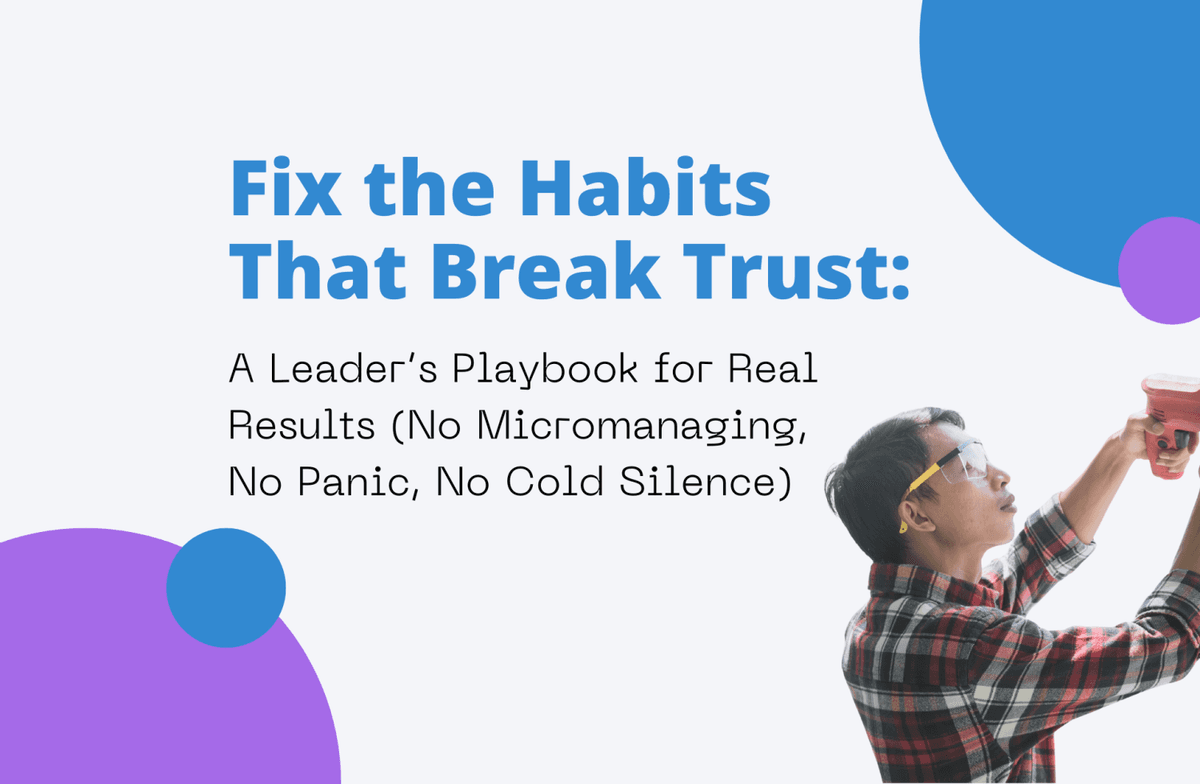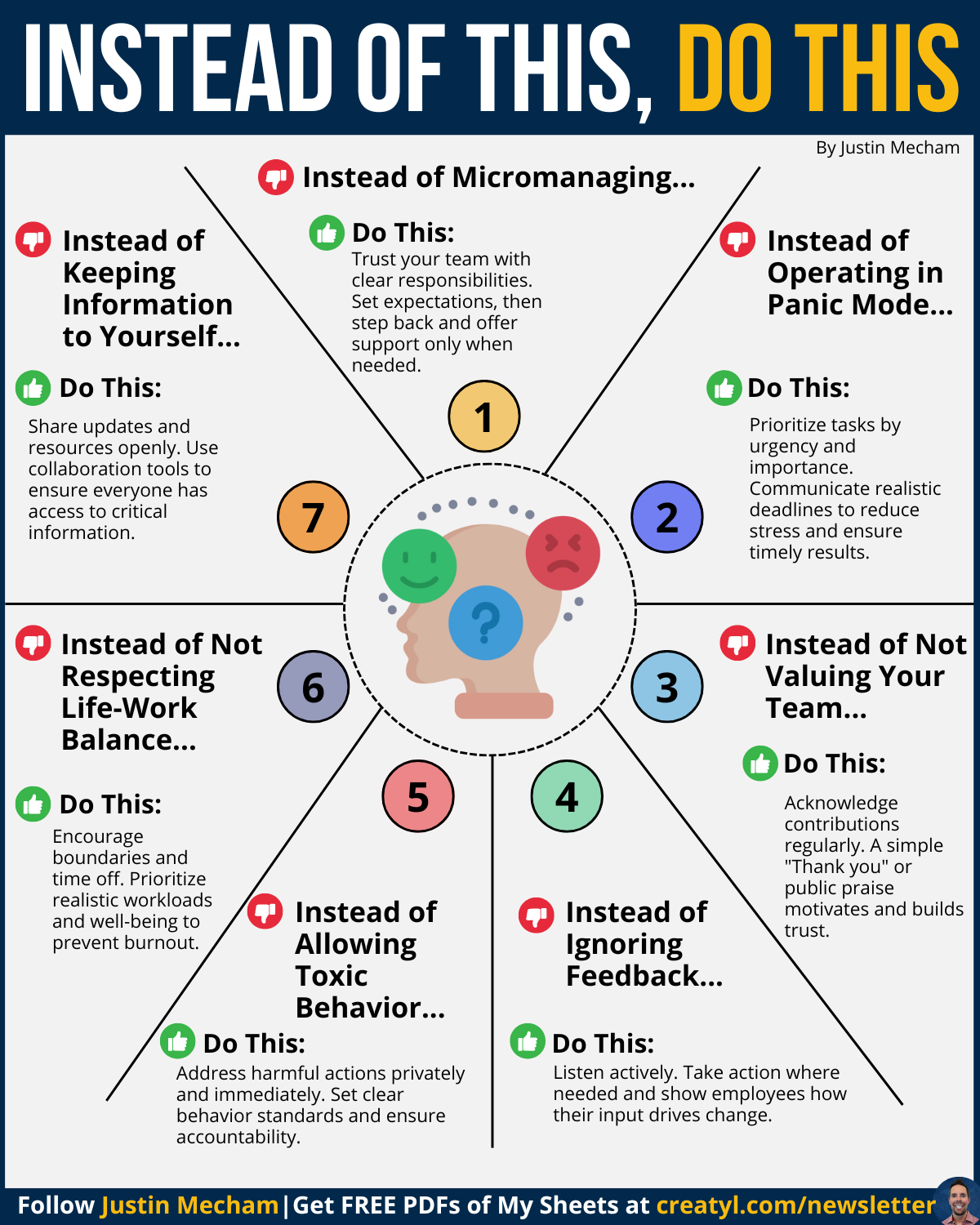Click Here to Download the PDF
Every workplace has patterns that quietly shape how people feel, show up, and perform.
Some habits build trust. Others quietly chip away at it.
It’s not usually the big mistakes that derail a team—it’s the small, everyday behaviors that get normalized over time.
Micromanaging. Withholding information. Letting toxicity slide. Ignoring feedback.
These aren’t skill gaps.
They’re leadership defaults that spread fast when no one stops them.
But the solution isn’t more hustle, tighter control, or endless initiatives.
Great leadership is rarely about doing more.
It’s about doing less of what breaks trust—and more of what builds it.
Below is a full guide built from real consulting work, research-backed methods, and practical tools that actually work in the chaos of real teams.
Why This Matters More Than You Think
If you’ve ever felt like your team has the talent but keeps missing its potential, you’re not imagining it.
Teams rarely fail because of lack of skill—they fail because of bad habits that feel normal.
Micromanaging feels like “staying on top of things,” but it kills ownership and slows decisions.
Withholding information feels like “protecting the team from confusion,” but it creates silos, frustration, and second-guessing.
Tolerating toxic behavior often comes from avoiding discomfort.
Ignoring feedback? Usually it’s because you’re moving too fast.
But the result is always the same: silence replaces trust.
Harvard Business School research shows that when employees feel controlled, their creativity drops sharply.
When psychological safety disappears, problem-solving collapses.
And when recognition goes missing, performance flatlines even in high-talent environments.
The core message? What you normalize becomes your culture.
And your culture shapes every decision, conversation, and outcome.
How One Team Broke Free from Bad Habits
A 20-person product team was burning out under the weight of their own process.
Deadlines kept slipping.
The manager was exhausted—checking every decision, jumping into every thread, trying to hold everything together.
Engineers felt micromanaged, so they stopped taking initiative.
Important updates stayed trapped in private docs.
Tension filled meetings where two voices dominated and ten stayed silent.
People didn’t quit loudly—they checked out quietly.
One senior engineer said, “We don’t need a new process. We just need to breathe again.”
Every week looked the same: too many meetings, too little clarity, and constant context-switching.
The manager was working 60-hour weeks and still behind.
Nobody was intentionally toxic, but snide comments and sarcasm had become “just how we talk.”
Ideas stopped surfacing. Trust broke down.
And despite working harder than ever, the results kept slipping.
The team wasn’t underperforming because they didn’t care—they were breaking under habits that punished effort and rewarded silence.
I stepped in as a consultant and ran what I call a 14-Day Reset—a rapid experiment to rebuild trust through small, visible wins.
The goal wasn’t to launch another initiative.
It was to make the team’s good habits impossible to ignore.
Step 1: Replace Micromanagement with Clarity + Check-Ins
We built one-page Task Briefs for every key project—outcomes, owners, deadlines, and a clear definition of “done.”
Check-ins became 15-minute weekly sessions.
Outside of that, the manager didn’t step in unless something truly slipped.
Within two weeks, the tension dropped.
People started solving problems again instead of waiting for permission.
Step 2: Replace Withholding with Radical Transparency
We created two doors of communication.
Door A: a short weekly “Ops Note” with wins, risks, and decisions.
Door B: a shared doc titled “What I Know / What I Decide / What I’m Unsure About.”
The effect was immediate.
No more “Did you know?” questions. Fewer surprises. Faster decisions.
Step 3: Address Toxic Behavior within 24 Hours
I introduced the “24-hour rule.”
If someone crossed a line, it was addressed privately within one day.
We used a simple script: “When you did X, the effect was Y. That can’t continue. Here’s the standard.”
No drama. No delay.
Just accountability. Within a week, meetings sounded different—quieter voices started contributing again.
Step 4: Close the Feedback Loop
We started a monthly pulse: “What’s one thing we should stop, start, or keep?”
I summarized responses, acted on one change, and reported back: “You said this, we did this.”
That loop—Ask, Echo, Act, Close—rebuilt the link between feedback and trust.
Step 5: Calm the Panic with the 3-Box Method
Every Monday, we sorted work into three boxes: Must Ship Today, Moves the Goal, and Noise.
The last category got deleted, delayed, or delegated.
It was shocking how much time “Noise” had been eating up.
Suddenly, focus came back.
Step 6: Protect Energy with Quiet Hours
Each person blocked two daily “no-ping” hours and one 90-minute deep-work block.
No meetings. No Slack storms.
Just breathing room to think.
Productivity rose, but more importantly—so did energy.
People were finally finishing the day with something left.
Step 7: Build a Culture of Real Recognition
We created the 5-5-1 rhythm: five quick notes of specific thanks, five shoutouts in meetings, one longer thank-you each week telling the story of impact.
Recognition stopped being generic—it became a habit. Within a month, even the skeptics were doing it too.
In 30 days:
- Cycle time improved by 18%.
- The release hit its target for the first time in six months.
- Meeting time dropped by a quarter.
- Two high performers who planned to leave decided to stay.
- The team’s survey score for “I feel safe to speak up” jumped 30%.
The most powerful part wasn’t the data—it was the tone.
They laughed in meetings again. They disagreed openly. They started building instead of surviving.
The 7 Moves You Can Steal Right Now
These aren’t abstract theories—they’re small, repeatable behaviors that rewire how a team operates.
1. Task Clarity + Check-In Cadence
Define outcomes, not steps.
Replace constant supervision with structured support.
Weekly check-ins give people space to lead their own work—and leaders room to think strategically.
2. Two-Door Transparency
One door pushes info out regularly (Ops Note).
The other pulls questions in openly (shared doc).
The combo keeps communication clean and self-sustaining.
3. The 24-Hour Rule
Silence lets toxicity grow roots.
Address harmful actions quickly, privately, and specifically.
Then reset the standard publicly.
4. Ask → Echo → Act → Close
Feedback that goes nowhere kills morale.
Feedback that sparks visible change fuels ownership.
5. 3-Box Priorities Sort
Urgency is addictive—but not everything urgent matters.
Protect the time for the work that moves the goal, not just today’s fire.
6. Quiet Hours + Deep Work
If everything’s urgent, nothing’s important.
Structured quiet time saves energy and builds quality.
7. 5-5-1 Recognition Rhythm
Recognition doesn’t need banners or bonuses.
It needs consistency.
Make gratitude a normal part of work, not a special event.
Tools and Resources Worth Your Time
- Book: The Fearless Organization by Amy C. Edmondson — the gold standard for building psychological safety.
- TED Talk: Why Good Leaders Make You Feel Safe by Simon Sinek — a must-watch on why safety outperforms control.
- Podcast: WorkLife with Adam Grant: “Is It Safe to Speak Up at Work?” — a masterclass in voice, trust, and modern culture.
- AI Tool: Otter.ai Meeting Agent — captures and summarizes meetings, so information never gets lost again.
- Tool: Loom (by Atlassian) — short video updates that replace panic meetings with calm context.
- TV Show: Ted Lasso — yes, fiction—but its leadership lessons on belief, humility, and accountability are painfully real.
Your 7-Day Action Plan
If you want change fast, start small and stay consistent.
Day 1: Build your first Task Brief and schedule the check-in.
Day 2: Send a Friday Ops Note.
Day 3: Set quiet hours and deep work blocks.
Day 4: Run a feedback pulse using Ask → Echo → Act → Close.
Day 5: Sort next week’s tasks into three boxes.
Day 6: Apply the 24-Hour Rule—address one behavior immediately.
Day 7: Practice the 5-5-1 recognition rhythm.
This isn’t about grand gestures. It’s about new habits that compound every week.
The Real Work of Leadership
Trust doesn’t crumble in a moment.
It erodes one small action at a time—one withheld update, one ignored idea, one quiet dismissal.
And it’s rebuilt the same way.
In moments. In micro-decisions.
In the leader who pauses before reacting. In the manager who asks, “What am I not seeing?”
In the team that dares to reset what they’ve normalized.
Leadership isn’t about keeping everyone comfortable.
It’s about keeping everyone honest, connected, and clear.
If you build systems that protect safety and standards at the same time, your team doesn’t just perform better—they feel better doing it.
Do less of what breaks trust.
Do more of what builds it.
And watch what happens when the culture starts leading itself.
Download the Infographic
Want a visual reference of every lesson from this article?
Download the full “Instead of This, Do This” infographic as a free PDF—perfect for your desk, your team Slack, or your next 1:1.
It’s the one-page version of this playbook—so you can start making real changes today.





